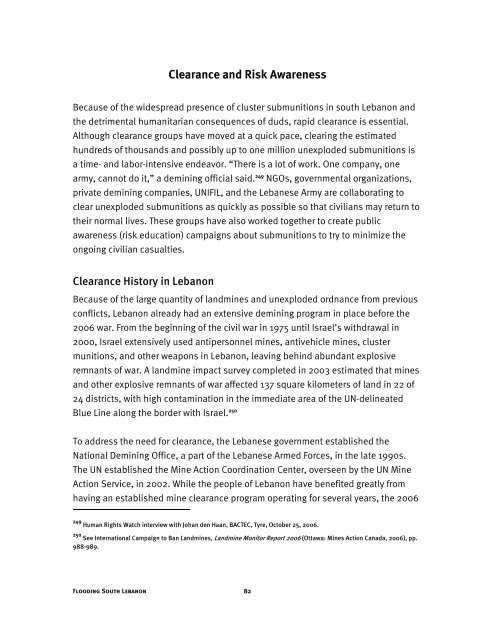Flooding South Lebanon - Human Rights Watch
Flooding South Lebanon - Human Rights Watch
Flooding South Lebanon - Human Rights Watch
You also want an ePaper? Increase the reach of your titles
YUMPU automatically turns print PDFs into web optimized ePapers that Google loves.
Clearance and Risk Awareness<br />
Because of the widespread presence of cluster submunitions in south <strong>Lebanon</strong> and<br />
the detrimental humanitarian consequences of duds, rapid clearance is essential.<br />
Although clearance groups have moved at a quick pace, clearing the estimated<br />
hundreds of thousands and possibly up to one million unexploded submunitions is<br />
a time- and labor-intensive endeavor. “There is a lot of work. One company, one<br />
army, cannot do it,” a demining official said. 249 NGOs, governmental organizations,<br />
private demining companies, UNIFIL, and the Lebanese Army are collaborating to<br />
clear unexploded submunitions as quickly as possible so that civilians may return to<br />
their normal lives. These groups have also worked together to create public<br />
awareness (risk education) campaigns about submunitions to try to minimize the<br />
ongoing civilian casualties.<br />
Clearance History in <strong>Lebanon</strong><br />
Because of the large quantity of landmines and unexploded ordnance from previous<br />
conflicts, <strong>Lebanon</strong> already had an extensive demining program in place before the<br />
2006 war. From the beginning of the civil war in 1975 until Israel’s withdrawal in<br />
2000, Israel extensively used antipersonnel mines, antivehicle mines, cluster<br />
munitions, and other weapons in <strong>Lebanon</strong>, leaving behind abundant explosive<br />
remnants of war. A landmine impact survey completed in 2003 estimated that mines<br />
and other explosive remnants of war affected 137 square kilometers of land in 22 of<br />
24 districts, with high contamination in the immediate area of the UN-delineated<br />
Blue Line along the border with Israel. 250<br />
To address the need for clearance, the Lebanese government established the<br />
National Demining Office, a part of the Lebanese Armed Forces, in the late 1990s.<br />
The UN established the Mine Action Coordination Center, overseen by the UN Mine<br />
Action Service, in 2002. While the people of <strong>Lebanon</strong> have benefited greatly from<br />
having an established mine clearance program operating for several years, the 2006<br />
249 <strong>Human</strong> <strong>Rights</strong> <strong>Watch</strong> interview with Johan den Haan, BACTEC, Tyre, October 25, 2006.<br />
250 See International Campaign to Ban Landmines, Landmine Monitor Report 2006 (Ottawa: Mines Action Canada, 2006), pp.<br />
988-989.<br />
<strong>Flooding</strong> <strong>South</strong> <strong>Lebanon</strong> 82
















